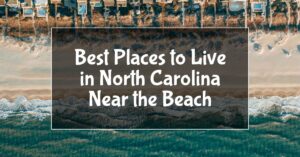Have you ever wondered which places might not be the best fit for calling home in North Carolina? The Tar Heel State has a wealth of beautiful cities and charming towns, but like anywhere else, not every location is ideal for everyone. Whether it’s due to economic factors, crime rates, or simply the vibe of a community, some areas can be less desirable to live in. Let’s take a closer look at the 10 worst places to live in North Carolina, shedding some light on why they might not be your perfect match.

10 Worst Places to Live in North Carolina
1. Durham
Durham has a notorious history of crime, particularly related to the crack cocaine epidemic in the 90s. Despite efforts to improve, shootings, murders, and assaults remain high, with 190 people shot last year. The city's racial and economic divisions persist, contributing to ongoing challenges.
- Durham ranks as one of the top 10 most dangerous cities in North Carolina for violent crime.
- The city has made efforts to gentrify, but the socioeconomic divide remains stark, particularly between new tech workers and long-time residents.
2. Whiteville
Whiteville, with a population of 5,400, is deemed the most dangerous place in North Carolina according to the FBI. Residents face a staggering 1 in 10 chance of being a property crime victim. The town struggles with poverty, high drug use, and limited job opportunities, resulting in widespread hardship.
- Whiteville has one of the highest property crime rates in the country.
- A third of the population lives in poverty, contributing to high rates of crime and drug use.
3. Albemarle
Located 45 minutes from Charlotte, Albemarle suffers from the highest drug overdose rate in the state. With a 1 in 16 chance of being attacked or robbed annually, high poverty rates, and poor job prospects, it's a town battling significant socioeconomic issues.
- Albemarle has the fourth-highest violent crime rate in North Carolina.
- The town has a 25% poverty rate, with unemployment three times higher than the national average.
4. Salisbury
Salisbury, known as “Shotsberry,” ranks 10th in the state for crime rates. High poverty, frequent gang violence, and a lack of cultural amenities characterize this medium-sized city. Despite some economic ties to companies like Cheerwine and Food Lion, it remains a challenging place to live.
- Salisbury has a violent crime rate significantly higher than the state average.
- The city's poverty rate is over 20%, contributing to the high levels of crime and economic stagnation.
5. Rocky Mount and High Point
Both Rocky Mount and High Point face severe crime and drug issues. Rocky Mount, a Raleigh suburb, is plagued by violence and poverty, while High Point is one of the 25 deadliest cities in the U.S., with a significant murder rate and a segregated community.
- Rocky Mount has a violent crime rate three times higher than the national average.
- The city suffers from high unemployment and limited recreational activities for families.
- High Point has a murder rate of 16 per 100,000 people, making it extremely dangerous.
- The city is heavily segregated, with distinct racial and economic divides.
6. Winston-Salem
Despite its size and historical significance, Winston-Salem has large areas of poverty and crime. Twenty percent of the population lives in poverty, and the city experienced its deadliest year in 25 years. Efforts to gentrify are underway, but many areas remain dangerous and run down.
- Winston-Salem has experienced a five-year increase in crime rates, making parts of the city highly unsafe.
- Gentrification efforts are ongoing, but the city's poverty rate remains at 20%.
7. Laurinburg
Near the South Carolina border, Laurinburg has a high poverty rate with one-third of its residents living at or below the poverty line. The town struggles with crime, lack of job opportunities, and economic stagnation, making it a tough place to thrive.
- Laurinburg has the fifth-highest violent crime rate in North Carolina.
- The unemployment rate is over 15%, with many residents chronically unemployed.
8. Fayetteville
Known as “Fayettenam,” Fayetteville is the largest city on this list and has significant violence and poverty issues. With limited job prospects, underfunded schools, and a high STD rate, it ranks poorly for families and employment opportunities.
- Fayetteville has a poverty rate of over 20%, with significant homelessness issues.
- The city's schools are underfunded, impacting the quality of education.
9. Lumberton
Lumberton, near the South Carolina border, is so plagued by crime that it stopped reporting to the FBI. Forty percent of its population lives in poverty, and robberies are frequent. It's a struggling community with limited prospects for improvement.
- Lumberton has a poverty rate of 40%, with many residents relying on government assistance.
- The city has one of the highest robbery rates in the state.
10. Kinston
Kinston, the worst place to live in North Carolina, has extreme poverty and crime rates. With a crime index of 1 out of 100, residents have a 1 in 13 chance of being a crime victim annually. The economic decline and high unemployment make it a challenging place to live.
- Kinston has the third-highest unemployment rate in North Carolina.
- The city is nearly four times more dangerous than the national average.
Conclusion: Finding Your Perfect Fit
While North Carolina offers many great places to live, these ten locations present significant challenges with crime, poverty, and limited job opportunities.
While some cities in North Carolina may have certain drawbacks, they also hold unique qualities that can be appealing. It’s all about what you prioritize.
If you're considering moving to North Carolina, aim for the more prosperous areas like the Raleigh metro, Charlotte, or the coastal regions. Avoid the troubled spots mentioned here to ensure a better quality of life.
As you consider potential places to call home in North Carolina, it’s crucial to weigh the pros and cons of each location. Not everyone will thrive in the same environment, and what may be a deal-breaker for one person could be a non-issue for another. It’s about finding the right fit for you and your lifestyle.
Whether that’s economic opportunities, community safety, cultural vibrancy, or even the schools available to your children, your checklist for the perfect home is unique to you.
Ultimately, it’s worth investing time in research and understanding what each place can offer. North Carolina is a state rich with diverse communities, and your perfect living situation is out there, waiting for you to discover it.
***For more in-depth info on these places in North Carolina you should never move to, you may watch the video given above***
- Best Places to Live in North Carolina Near the Beach
- 10 Safest Places to Live in North Carolina
- Worst Places to Live in the New York State
- Worst Places to Live in Florida for Families & Retirees
- Worst Cities in California: These Are Worst Places to Live in CA
- Worst Places to Live in Texas: Avoid These Texas Towns
- 20 Worst Places to Live in the US: Avoid These Cities




